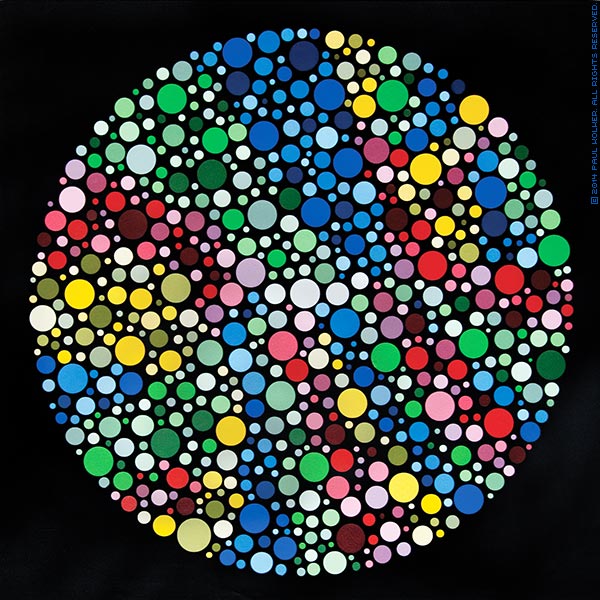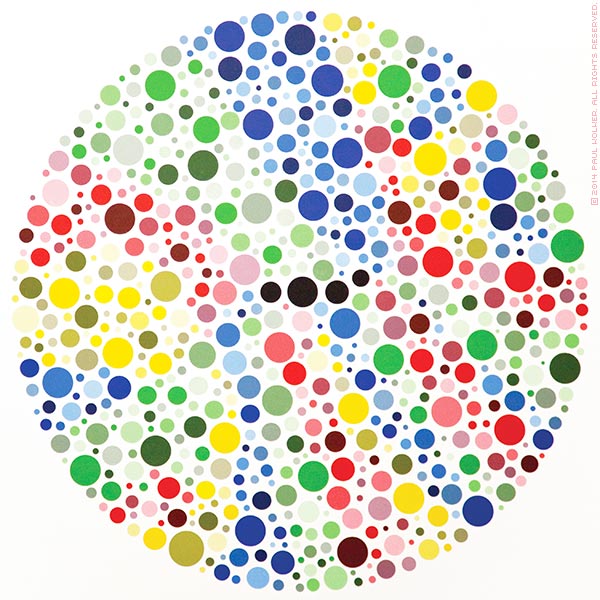[New York — March 20, 2014] Paul Kolker is pleased to present Halftones and Ishidots…The New Abstract! opening on May 1, 2014 at the Paul Kolker collection, 511 West 25th Street. With this exhibition, Kolker launches his return to both abstract painting and light sculpture with his yearlong series called “The New Abstract!”. In his sculptures, curved mirrors reflect, distort and thereby abstract light into infinity. In each painting, Kolker stays true to his minimal color theory and referential use of his dots, reminding us of the way we have come to see things on the digitally printed page as well as on our computer, television and smartphone screens; but, as in this exhibition, through the new abstract closeup lens of Kolker’s metaphorical microscope.
 Paul Kolker: Ishidots Circulare Noir, OP.1, 2014, acrylic on canvas, 55 x 55 x 3 inches
Paul Kolker: Ishidots Circulare Noir, OP.1, 2014, acrylic on canvas, 55 x 55 x 3 inchesIn Paul Kolker: Halftones and Ishidots…The New Abstract!, Kolker continues with his paradigm of art as as experiment which uses the perception of the viewer, including the artist, as the measuring instrument; albeit a subjective one. What turns the viewer on or off when looking at an abstracted dot painting is a major decider of outcome for a labor intensive form of Kolker’s art production. Of course, few abstract compositions get the artist’s nod in his selection of works that make it into the exhibition. Also, it is hard to rework a dot painting canvas; so the outcome of an abstract painting itself is quintessentially binary _ it is either on or off! A portrait, landscape or still life may be good even if not masterful; however an abstracted dot painting, (which Kolker coined ‘abfrac’ in 2002, to mean ‘fractionated abstraction’ in attribution to Benoit Mandelbrot’s fractal geometry), must be planned de novo from that abstraction which only the artist sees in his real world or invents with his imagination.
The art historical and scientific bases for the works in this exhibition are founded in the technologies spawned by the development and wide use of photography before the mid-nineteenth century. Early halftone print methods were based on the work of William Fox Talbot, Frederic Ives and Benjamin Day. Screens of dots of various sizes were used to transfer photographic images to the printed page in black and white gradients and ultimately in color. It is therefore no surprise that in 1915 when Dr. Shinobu Ishihara, an ophthalmologist in the Royal Japan Air Force (RJAF) and acclaimed for his color blindness research, had painted dots of various sizes and colors on the paper cards he used to test color vision in his patients, RJAF pilots.
 Paul Kolker: Ishidots Circulare Blanc, OP.1, 2014, acrylic on canvas, 55 x 55 x 3 inches
Paul Kolker: Ishidots Circulare Blanc, OP.1, 2014, acrylic on canvas, 55 x 55 x 3 inchesKolker (born 1935) is known for his light sculptures and also his paintings and prints incorporating rectilinear grids of dots, halftone phases and curvilinear patterns of multivariate dots; the latter which he calls Ishidots in attribution to Shinobu Ishihara. The optical color mixing effect of colored dots painted on a white ground is that of a tint. When painted on a black ground, those same colors are perceptually enhanced by the Wilhelm von Bezold optical mixing effect, as demonstrated in the juxtaposed images of the works depicted above. In both paintings the dots are painted in the same hues; but those on the black ground appear more saturated and emboldened, like bright stars in a black night sky; or, perhaps, like yesteryear’s Fauvist wild-beastly colors outlined in black.
Paul Kolker: Halftones and Ishidots…The New Abstract! is on view from May 1, 2014 through July 3, 2014 at the Paul Kolker collection, 511 West 25th Street adjacent to the High Line between Tenth and Eleventh Avenues. For information please call 212.367.7300, email info@paulkolker.com or visit paulkolker.com.
